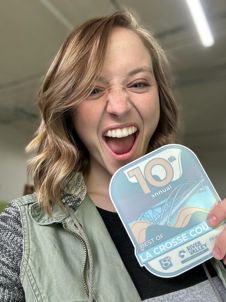Is It JUST Calories In, Calories Out?
2023-12-18
Megan Berner, Dietitian (Nourish To Flourish), Fitness Coach (Fitness Lying Down)

When it comes to nutrition, calories are a big topic of discussion. At their most basic definition, calories are units for energy. The technical definition is the amount of energy required to increase the temperature of 1g of water by 1 degree celsius. (How sophisticated, right?!) Calories aren’t good or bad. They just are the literal, a calorie is a calorie. You’ve maybe heard the riddle, what weighs more – a pound of bricks or a pound of feathers? Well they’re both a pound! However, a pound of bricks is going to look differently than a pound of feathers. The tricky thing when it comes to calories is what else comes with them (or what doesn’t come with them). The analogy I like to use with clients is a calorie is a calorie, but what does that calorie carry in its nutrient backpack? For example, 50 calories of almonds has different nutrients in the “backpack” compared to 50 calories of chicken breast or 50 calories of pickles. They’re all isocaloric, but they’re not isometabolic. The things present (or missing) from the backpack have impacts on our health and our goals. The point is, counting calories only gets you so far, and oftentimes it sets you up for a failed relationship with your body and with food.
Keeping in mind the definition of calories as units of energy, we need energy to perform functions in our body – functions like muscle contraction, but also to power our brain, to breathe, for our heart to beat, to transport nutrients around in our blood and into cells. This bar graph breaks down the things that we need energy for in our body.

The first chunk is for our basal metabolic rate (BMR). Sometimes this is referred to as resting energy expenditure (REE). This includes all the basic functions to just keep you alive. Things that determine this number include age, height, weight, genetics, and muscle mass! The more muscle you have the larger this chunk is. This is an incentive to strength train – it supports your metabolism! I like to tell clients it’s the “bare minimum requirements” for energy. If you’re eating this amount or less than this, then your body is not properly fueled. This is not enough calories.
The next chunk is for TEF or thermogenic effect of food. This simply means that it costs energy to digest and absorb food. This is also an area where people can be tricked by marketing and different supplements. Look at how big this bar graph is! I share one macronutrient that has a greater impact on TEF as a part of one of the mistakes in my 10 Mistakes in Nutrition and Behavior Change program!

A great article from Nutrition Reviews, “Foods, obesity, and diabetes—are all calories created equal?”
The next category is NEAT which stands for non exercise activity thermogenesis. This is all activity that you do as a part of your daily living. This is not intentional activity. There is a lot of variance with how big this bar is from person to person. NEAT is exercise activity thermogenesis. Now we’re talking about intentional activity. We also have influence over this. There’s plenty of wearables on the market that can estimate calorie usage during activity. Remind yourself it’s just that, an estimate! These last two categories are the ones we have the most control over.
In the end, you need a good amount of calories just to stay alive. You need a good amount of calories to fuel your average daily functions. You need a good amount of calories to fuel your activity. This is then an opportunity where I discuss with clients how to combine foods in a way that can cross off energy needs that are also satiating. It’s one thing to hit number needs, but it’s another to make sure you’re feeling satisfied. You can see below that once again, calories are a thing, but what else is in their backpack like other nutrients and more appetite satisfaction!

If you don’t know where to start with determining how many calories you or your clients need, find a dietitian (or reach out to me!) who can help with calculations and put those numbers into context! It isn’t complicated but severe restriction should not be your goal either!
View this post on Instagram
Now that you know better, let’s go out and do better, so we can all be better!
Don’t miss our VERY limited time flash sale on our combo Ultimate Sandbag packages that can either really expand your DVRT gym or be the amazing start to your DVRT gym. Just use code “flashsale” HERE
Listen to Megan discuss the myths of calories HERE
© 2024 Ultimate Sandbag Training. Site by Jennifer Web Design.







